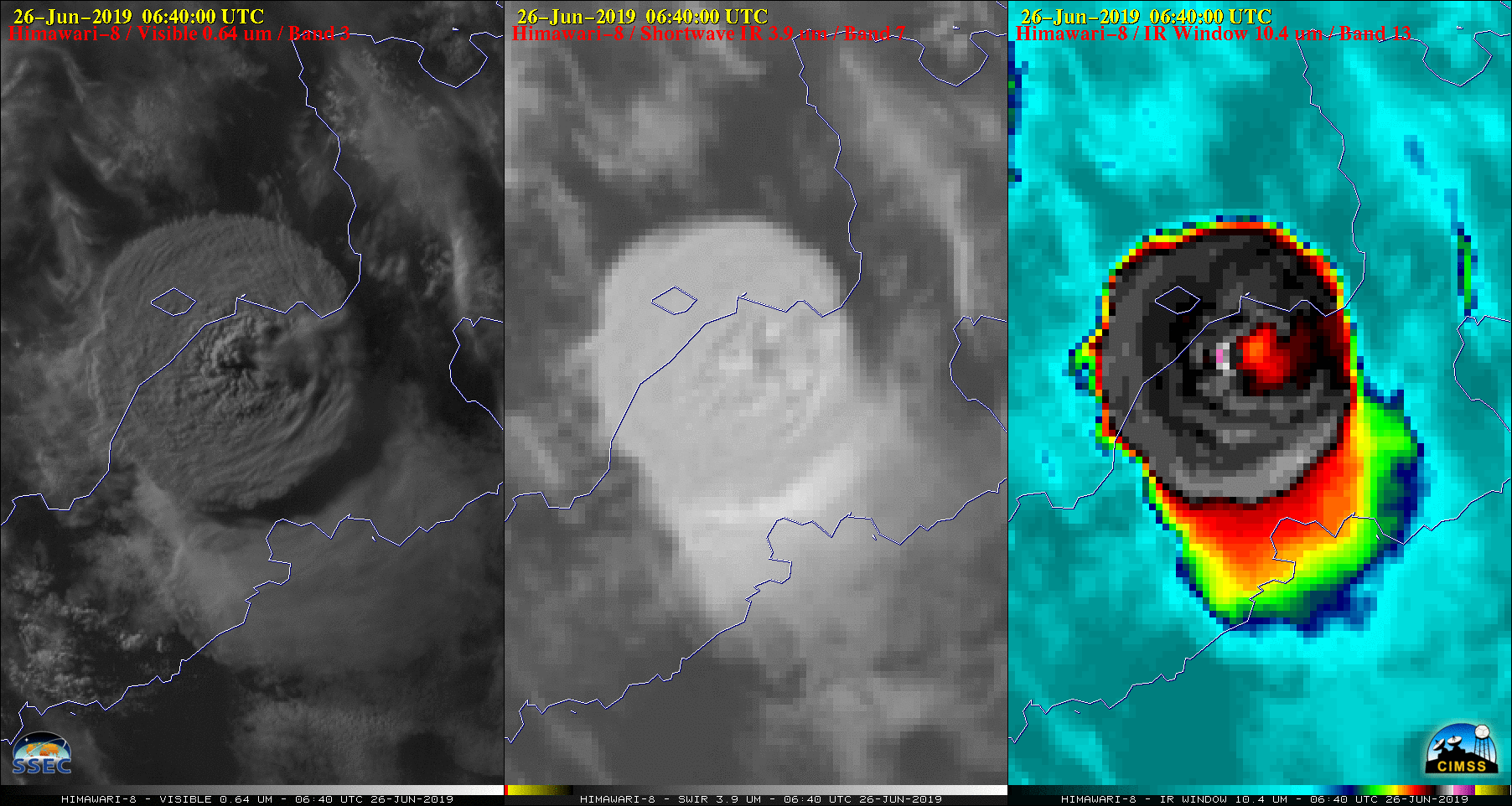
[ Archive ]

 |
CIMSS-NOAA Weekly Report [ Archive ] |
 |
ASPB AND CIMSS WEEKLY HIGHLIGHTS FOR THE WEEK ENDING JUNE 28, 2019
IN THE PRESS:
ITEMS FOR THE ADMINISTRATOR:
ITEMS FOR THE ASSISTANT ADMINISTRATOR:
ITEMS FOR THE OFFICE DIRECTOR, STAR:
GOES-13 Temporarily Brought Out Of Storage: Geostationary Operational Environmental Satellite (GOES)-13 was brought out of storage mode on 19 June 2019. The University of Wisconsin-Madison's Space Science and Engineering Center (SSEC) the Satellite Data Services (SDS) group re-positioned their 4.5 meter antenna, which was receiving data from GOES-15 at 128.1ºW in a back up configuration, to point at GOES-13 at 60.2ºW. GOES Variable (GVAR) data began to be ingested at SSEC on 20 June, is expected to continue until 03 July, and all GOES-13 data are being captured and stored in the SSEC online archive. Cooperative Institute for Meteorological Satellite Studies (CIMSS) scientists have been evaluating the data, primarily for Image Navigation and Registration (INR), generating loops of imagery and providing feedback to the satellite operators at NESDIS. Some loops and details are on the CIMSS Satellite Blog at http://cimss.ssec.wisc.edu/goes/blog/archives/33568. (Tim Schmit, E/RA2, 608 263 0291, Jerrold Robaidek, SSEC, Scott Bachmeier, CIMSS, Jim Nelson, CIMSS, Mat Gunshor, CIMSS).
(Click image to enlarge)
Figure: The five spectral bands of the Geostationary Operational Environmental Satellite (GOES)-13 Imager on 25 June 2019 at 19:45UTC. GOES-13 is out of storage for testing by NESDIS from June 20 to July 3, 2019.
2019 CIMSS Student Workshop: The Cooperative Institute for Meteorological Satellite Studies (CIMSS) hosted it's annual Summer Workshop this week for 17 high school students from 11 different states. Topics included satellite remote sensing, meteorology, climate change, astronomy, limnology and geology. Students also enjoyed several field trips including hiking at a near-by state park, visiting several science destinations on the University of Wisconsin-Madison campus, a local TV weather station and a visit to the Milwaukee-Sullivan National Weather Service Forecast Office. The CIMSS Student Workshop on Atmospheric, Satellite, and Earth Sciences was established in 1991. For more information please visit http://cimss.ssec.wisc.edu/studentworkshop/. (D.Herndon, CIMSS, dherndon@ssec.wisc.edu, M. Vasys, CIMSS, maria.vasys@ssec.wisc.edu, M. Mooney, CIMSS, margaret.mooney@ssec.wisc.edu)
ITEMS FOR THE DIVISION CHIEF, CoRP:
Presentation to Middle-School Teachers: Scott Lindstrom,Cooperative Institute for Meteorological Satellite Studies (CIMSS), gave a 75-minute remote presentation on Satellite Imagery and Remote Sensing to 18 Middle School Teachers from the states of Oregon, Washington and Montana at the request of Hilda Pereyo of the Northwest Earth and Space Sciences Pipeline. The talk included an overview of Geostationary Satellites, information on all Earth- and Sun-viewing instruments of GOES-East and GOES-West with a special focus on the Advanced Baseline Imager (ABI). The talk also described web-based GOES-R applications useful for middle-school teachers and noted where to find real-time GOES-16 and GOES-17 imagery on the web. The talk also described how to download raw data from the NOAA Comprehensive Large Array-data Stewardship System (CLASS) archive for display with Geo2Grid and the Satellite Information Familiarization Tool (SIFT), two display systems developed at CIMSS. A Question and Answer session followed the presentation. (Scott Lindstrom, CIMSS, 608 263 4425)
CIMSS Satellite Blog Updates: The Cooperative Institute for Meteorological Satellite Studies (CIMSS) Satellite Blog (http://cimss.ssec.wisc.edu/goes/blog/) was updated with the posts "Philadelphia Refinery Explosion in Conterminous United States (CONUS) and Mesoscale Sectors" (June 21), "Geostationary Operational Environmental Satellite (GOES)-13 brought out of storage" (June 21-25), "Eruption of the Raikoke volcano in the Kuril Islands" (June 21-25), "Space-X Falcon Heavy rocket launch signature" (June 25) and "Ulawun volcano erupts in Papau New Guinea" (June 26, 2019). (S. Bachmeier, CIMSS, S. Lindstrom, CIMSS, J. Nelson, CIMSS, M. Pavolonis, E/RA2)
 (Click image to enlarge)
(Click image to enlarge)
Figure: Volcanic cloud from the Ulawun eruption in Papau New Guinea, as seen in Himawari-8 Visible (0.64 µm, left), Shortwave Infrared (3.9 µm, center) and Infrared Window (10.4 µm, right) images at 0640 UTC on June 26, 2019.
VISITORS:
NEXT WEEK:
LOOKING AHEAD:
| Archived Weeklies Page | Submit a report item |